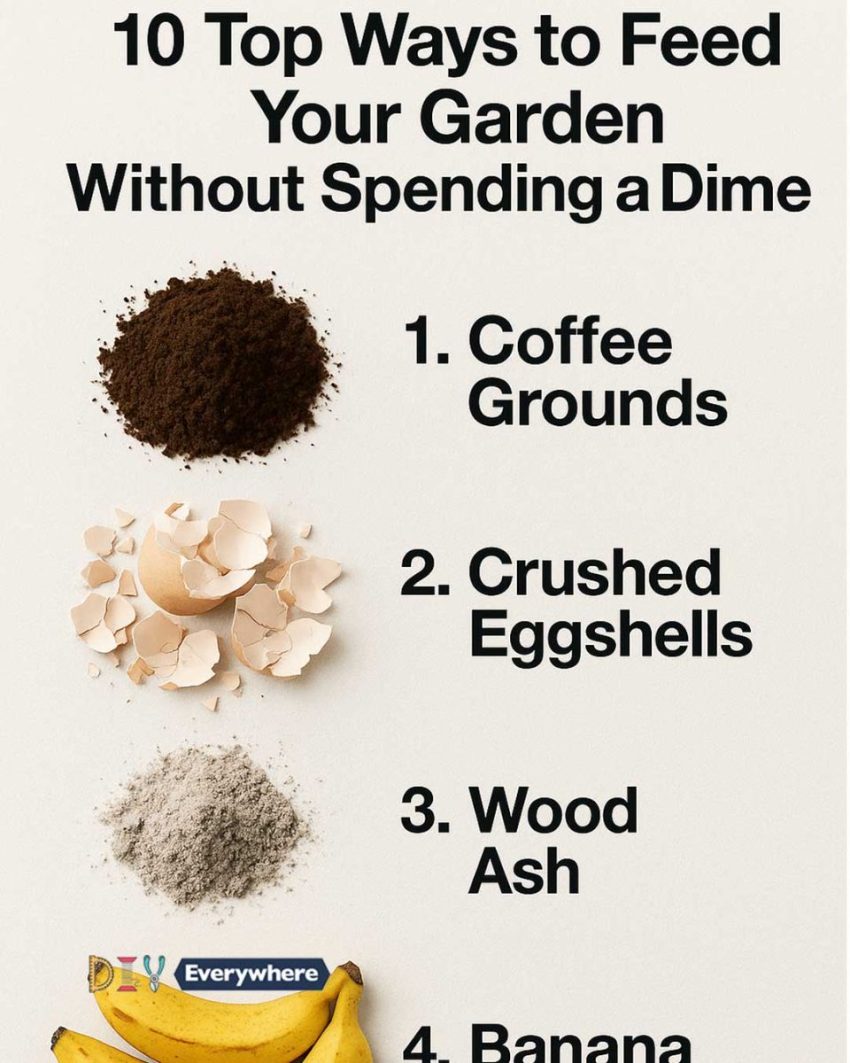ADVERTISEMENT
1. Harness the Power of Composting
Composting is one of the most effective ways to feed your garden without spending a dime. By recycling organic waste from your kitchen and yard, you can create a nutrient-rich compost that enhances soil fertility and promotes healthy plant growth. Start by collecting fruit and vegetable scraps, coffee grounds, eggshells, and yard waste such as grass clippings and leaves. Avoid adding meat, dairy, or oily foods, as these can attract pests and create odors.
To create a compost pile, choose a well-drained spot in your yard and layer your organic materials, alternating between green (nitrogen-rich) and brown (carbon-rich) materials. Keep the pile moist and turn it regularly to aerate and speed up the decomposition process. In a few months, you’ll have a dark, crumbly compost that can be mixed into your garden soil to improve its structure and nutrient content.
2. Coffee Grounds for Acid-Loving Plants
Used coffee grounds are an excellent source of nitrogen and can be particularly beneficial for acid-loving plants such as azaleas, rhododendrons, and blueberries. The grounds help to lower the pH level of the soil, making it more acidic, which is ideal for these types of plants.
To use coffee grounds in your garden, simply sprinkle them around the base of your acid-loving plants. You can also mix them into the top layer of soil or add them to your compost pile. If you don’t drink coffee at home, consider asking your local coffee shop for their used grounds, as many are happy to give them away for free.
3. Eggshells for Calcium Boost
Eggshells are a fantastic source of calcium, which is essential for plant cell growth and can help prevent blossom end rot in tomatoes and peppers. To use eggshells in your garden, start by rinsing them thoroughly to remove any residue. Once clean, allow them to dry completely.
Crush the dried eggshells into small pieces or grind them into a fine powder using a blender or mortar and pestle. Sprinkle the crushed shells around the base of your plants or mix them into the soil. Over time, the eggshells will break down and release calcium into the soil, providing a slow-release nutrient boost for your plants.
4. Banana Peels as a Potassium Source
Banana peels are rich in potassium, an essential nutrient that helps plants with water uptake, enzyme activation, and overall growth. Instead of throwing away banana peels, use them to feed your garden.
There are several ways to use banana peels in your garden. You can chop them up and bury them directly in the soil near the roots of your plants, or you can dry them and grind them into a powder to sprinkle around your garden. Alternatively, you can make a banana peel tea by soaking the peels in water for a few days and then using the liquid to water your plants.
5. Wood Ash for Alkaline Soil
Wood ash from a fireplace or wood stove can be a valuable addition to your garden, especially if you have acidic soil. Wood ash contains potassium and calcium carbonate, which can help raise the pH level of the soil, making it more alkaline.
To use wood ash in your garden, first ensure that it is completely cool and free of any charcoal or chemical residues. Sprinkle the ash lightly over your garden beds and mix it into the soil. Be cautious not to overapply, as too much ash can raise the pH too high and harm your plants. A general guideline is to use about 5 pounds of wood ash per 100 square feet of garden space.
6. Epsom Salt for Magnesium Deficiency
Epsom salt, or magnesium sulfate, is a natural mineral compound that can help correct magnesium deficiencies in plants. Magnesium is crucial for photosynthesis and helps plants absorb other nutrients more effectively.
To use Epsom salt in your garden, dissolve 1 tablespoon of Epsom salt in a gallon of water and use it to water your plants once a month. You can also sprinkle the salt directly around the base of your plants and water it in. This treatment is particularly beneficial for tomatoes, peppers, and roses, which are often prone to magnesium deficiencies.
7. Grass Clippings as a Nitrogen-Rich Mulch
Grass clippings are an excellent source of nitrogen and can be used as a mulch to feed your garden. By spreading a layer of grass clippings around your plants, you can help retain soil moisture, suppress weeds, and provide a slow-release source of nitrogen as the clippings decompose.
To use grass clippings as mulch, spread a 1- to 2-inch layer around your plants, being careful not to pile them too thickly, as this can lead to matting and mold. Avoid using clippings from lawns that have been treated with herbicides or pesticides, as these chemicals can harm your plants.
8. Fish Tank Water as a Natural Fertilizer
If you have a fish tank, the water that you remove during regular cleanings can be a valuable fertilizer for your garden. Fish waste contains nitrogen, phosphorus, and potassium, which are essential nutrients for plant growth.
To use fish tank water in your garden, simply pour it directly onto the soil around your plants. This nutrient-rich water will help improve soil fertility and promote healthy plant growth. Be sure to use water from freshwater tanks only, as saltwater can harm your plants.
9. Vinegar for Acidifying Soil
Vinegar is an inexpensive and natural way to lower the pH of your soil, making it more acidic. This can be beneficial for acid-loving plants such as blueberries, azaleas, and hydrangeas.
To use vinegar in your garden, mix 1 cup of white vinegar with a gallon of water and use the solution to water your plants. Be cautious not to overuse vinegar, as it can harm plants if applied in excessive amounts. Use this treatment sparingly and only when necessary to adjust soil pH.
10. Manure Tea for Nutrient-Rich Feeding
Manure tea is a nutrient-rich liquid fertilizer made by steeping manure in water. It provides a balanced mix of nitrogen, phosphorus, and potassium, along with other trace elements that are essential for plant growth.
To make manure tea, fill a burlap sack or pillowcase with well-aged manure (such as cow, horse, or chicken manure) and submerge it in a large container of water. Let it steep for a few days, stirring occasionally. Once the tea is ready, dilute it with water until it resembles weak tea and use it to water your plants. This will provide them with a gentle but effective nutrient boost.
11. Seaweed Solution for Trace Minerals
Seaweed is an excellent source of trace minerals, including iodine, potassium, and magnesium, which can benefit your garden. You can use fresh seaweed if you live near the coast, or purchase dried seaweed from a garden center.
To make a seaweed solution, soak fresh or dried seaweed in a bucket of water for a few days. Once the seaweed has steeped, strain the liquid and dilute it with water at a ratio of 1:10. Use this solution to water your plants, providing them with a natural source of trace minerals that can enhance growth and improve overall plant health.


